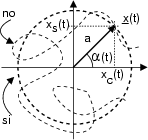In questo tipo di modulazione, l'informazione contenuta nel messaggio
x![]() t
t![]() è impressa sulla portante modificandone la fase:
x
è impressa sulla portante modificandone la fase:
x![]() t
t![]() = acos
= acos![]()
![]() t +
t + ![]()
![]() t
t![]()
![]() .
.

| = | 2x+ |
||
| = | a |

Si è già mostrato come siano adottati 2 diversi tipi di legame tra messaggio
m![]() t
t![]() e fase dell'inviluppo complesso
e fase dell'inviluppo complesso
![]()
![]() t
t![]() ,
indicati con PM (modulazione di fase) ed FM (modulazione di frequenza)
che nella tabella a fianco. In questa compare la frequenza istantanea
,
indicati con PM (modulazione di fase) ed FM (modulazione di frequenza)
che nella tabella a fianco. In questa compare la frequenza istantanea
- una PM con
m![]() t
t![]() pari all'integrale del messaggio informativo
oppure
pari all'integrale del messaggio informativo
oppure
- una FM con
m![]() t
t![]() pari alla derivata del messaggio informativo.
pari alla derivata del messaggio informativo.
Illustriamo subito alcune particolarità della modulazione angolare, prima di applicarci al problema della ricezione, ed alla determinazione della densità di potenza del segnale modulato.
La caratteristica fondamentale della modulazione angolare è che il segnale
modulato ha una dipendenza da
m![]() t
t![]() fortemente non
lineare, e pertanto lo spettro di densità di potenza
fortemente non
lineare, e pertanto lo spettro di densità di potenza
![]() x
x![]() f
f![]() del segnale modulato non può essere calcolato con le tecniche tradizionali.
Infatti, l'inviluppo complesso di un segnale modulato di angolo può essere espresso9.22 come:
del segnale modulato non può essere calcolato con le tecniche tradizionali.
Infatti, l'inviluppo complesso di un segnale modulato di angolo può essere espresso9.22 come:
La circostanza che
![]()
![]() t
t![]() = aej
= aej![]()
![]() t
t![]() presenti un modulo costante pari ad a, indipendentemente dalle ampiezze
del segnale modulante, è particolarmente utile, qualora per
m
presenti un modulo costante pari ad a, indipendentemente dalle ampiezze
del segnale modulante, è particolarmente utile, qualora per
m![]() t
t![]() siano da aspettarsi forti variazioni di dinamica. Questo è proprio il caso del
segnale FDM, utilizzato per multiplare in frequenza piú canali telefonici. In
questo caso infatti, non essendo noto a priori il numero di canali effettivamente
impegnati, la potenza del segnale
y
siano da aspettarsi forti variazioni di dinamica. Questo è proprio il caso del
segnale FDM, utilizzato per multiplare in frequenza piú canali telefonici. In
questo caso infatti, non essendo noto a priori il numero di canali effettivamente
impegnati, la potenza del segnale
y![]() t
t![]() =
= ![]() BLU
BLU![]() mn
mn![]() t
t![]() , fn
, fn![]() ottenuto sommando i diversi canali (ognuno a modulazione BLU con una diversa
portante) può variare di molto: allora, il segnale complessivo
y
ottenuto sommando i diversi canali (ognuno a modulazione BLU con una diversa
portante) può variare di molto: allora, il segnale complessivo
y![]() t
t![]() viene applicato all'ingresso di un modulatore FM e trasmesso come tale.
viene applicato all'ingresso di un modulatore FM e trasmesso come tale.
Come anticipato, per effettuare una modulazione PM
x![]() t
t![]() = k
= k![]() m
m![]() t
t![]() si può usare un modulatore FM, in cui
si può usare un modulatore FM, in cui
![]()
![]() t
t![]() = 2
= 2![]() kf
kf![]() m'(
m'(![]() )d
)d![]() ,
ponendo
m'
,
ponendo
m'![]() t
t![]() =
= ![]()
![]()
![]() m
m![]() t
t![]() .
Pertanto, consideriamo nel seguito solo le operazioni di modulazione/demodulazione
FM. Un metodo diretto di generare un segnale FM è quello di utilizzare
un VCO (già introdotto in (9.2.1.3)), ossia un oscillatore controllato in
tensione, che produce il segnale
x
.
Pertanto, consideriamo nel seguito solo le operazioni di modulazione/demodulazione
FM. Un metodo diretto di generare un segnale FM è quello di utilizzare
un VCO (già introdotto in (9.2.1.3)), ossia un oscillatore controllato in
tensione, che produce il segnale
x![]() t
t![]() = asin
= asin![]()
![]() t + 2
t + 2![]() kf
kf![]() m(
m(![]() )d
)d![]()
![]() ,
e dunque realizza proprio la funzione desiderata. Un secondo metodo verrà illustrato
per un caso particolare in appendice 9.4.5. Infine, è sempre
valido il modulatore in fase e quadratura, in cui si pone
xc
,
e dunque realizza proprio la funzione desiderata. Un secondo metodo verrà illustrato
per un caso particolare in appendice 9.4.5. Infine, è sempre
valido il modulatore in fase e quadratura, in cui si pone
xc![]() t
t![]() = cos
= cos![]()
![]() t
t![]() e
xs
e
xs![]() t
t![]() = sin
= sin![]()
![]() t
t![]() .
.